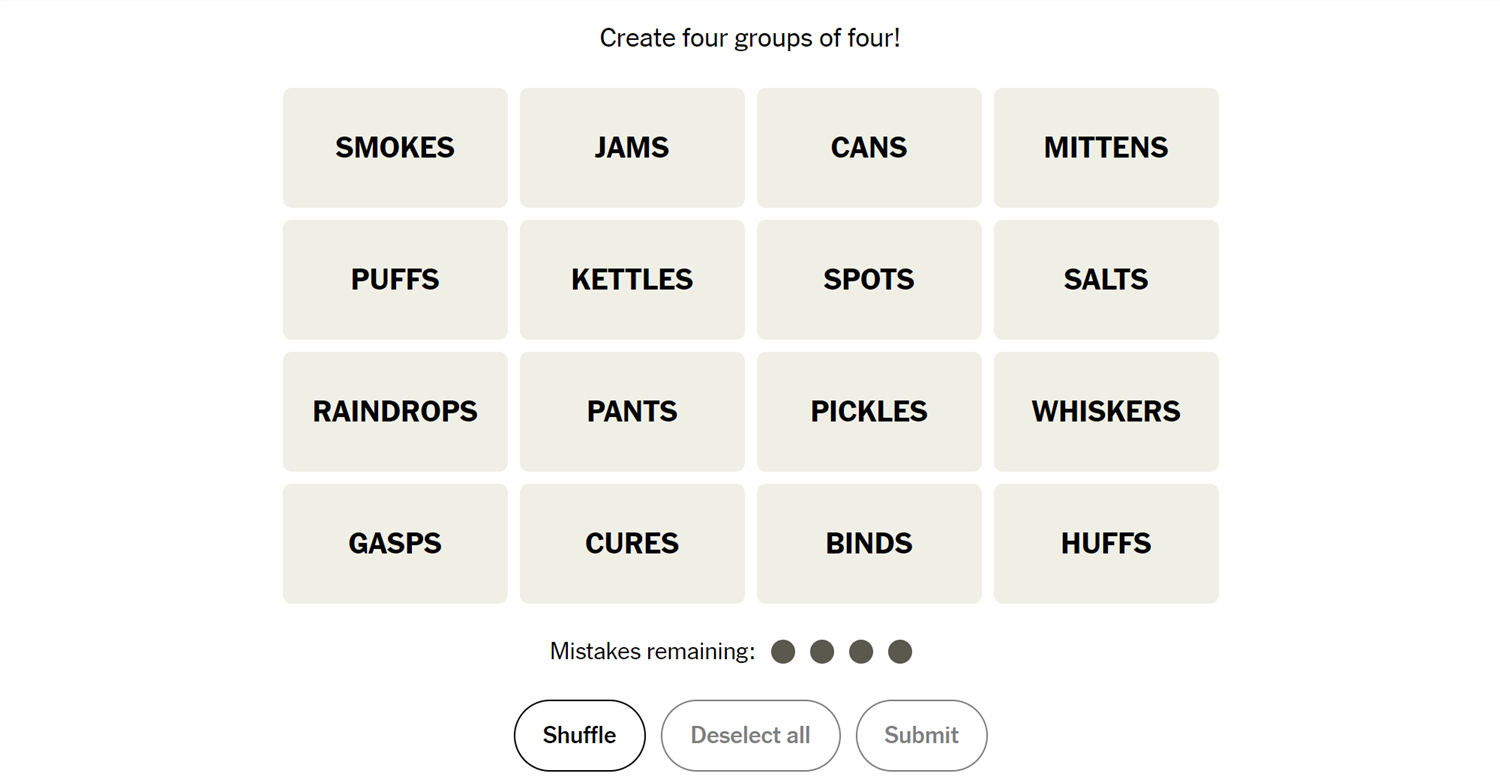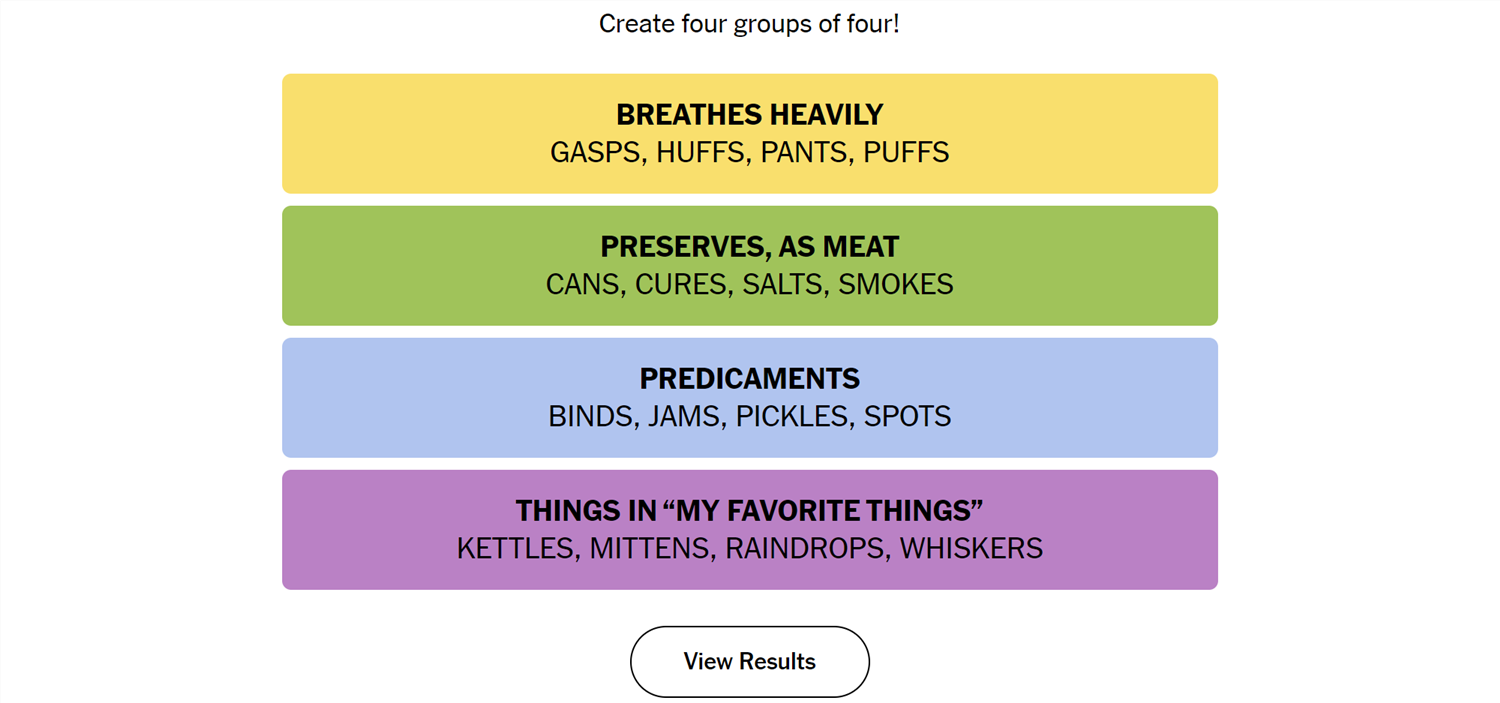Connections is a game from the New York Times that challenges you to find the association between words. It sounds easy, but it isn’t—Connections categories can be almost anything, and they’re usually quite specific. If you need a hand getting the answers, we’ve got you covered.
What Is Connections?
Connections is a puzzle game from the New York Times. The objective is simple: sort 16 words into groups of 4. Each group of words will be connected by some common idea or theme. That common element could be anything from the number of letters in the words to a common use for all the words. Once you’re confident, select 4 words, then hit “Submit.” You have only four attempts in total, so don’t be too guess-happy.
Hints for Today’s Connections Categories
Here are a few small hints to get you started on the 298th Connections game.
- Yellow: While hiking.
- Green: Long lasting.
- Blue: Unfortunate Positions.
- Purple: Try singing the words.
What Are Today’s Connections Categories?
If you’re still struggling, the actual categories are:
- Yellow: Breathes Heavily
- Green: Preserves, as Meat
- Blue: Predicaments
- Purple: Things in “My Favorite Things.”
Today’s Connections Answers
Yellow:
Gasps, Huffs, Pants, Puffs
Green:
Cans, Cures, Salts, Smokes
Blue:
Binds, Jams, Pickles, Spots
Purple:
Kettles, Mittens, Raindrops, Whiskers
How Did We Solve This Puzzle?
The first group of words that jumped out were huffs, puffs, gasps, and pants—all words used to describe heavy or difficult breathing. We took a shot with it, and it worked out. The Yellow category was “Breathes Heavily.” Pretty straightforward.
The next one was a little more challenging. Cans, cures, salts, smokes, jams, and pickles all seem related intuitively. They’re all related to food preservation, or foods that are preserved. Of those, jam is a noun (in this context), and pickle—while it can be a verb—is also often a noun. We chose to guess words that are only ways of preserving food: cans, cures, salts, smokes. Our guess was right, and the Green category is “Preserves, as Meat.” For the record, pickled meat is a thing, and we just got somewhat lucky with our reasoning. An example of pickled meat that you’re probably familiar with is corned beef, a meat frequently associated with Saint Patrick’s Day celebrations in the United States.
As usual, once there are fewer words, groups tend to get easier to spot. A bind, jam, pickle, or spot can all be used to describe a difficult situation, so we lumped those together. They made up the Blue category, which is named “Predicaments” today.
That leaves kettles, mittens, raindrops, and whiskers. These obviously make up the Purple category, but what is the fun in just clicking them without even trying to figure out the connection first? We hit shuffle repeatedly (a winning tactic, in our experience) to see if anything became clear, and then it happened: the words reordered, and the connection was almost startlingly obvious. It is even clearer if you say them out loud: raindrops, whiskers, kettles, mittens. Of course, these are the first four things Julie Andrews sings about in “My Favorite Things” from The Sound of Music.
How Do You Guess Connections Categories?
There is no quick, reliable way to approach Connections like there is with Wordle, since Connections isn’t algorithmic. However, there are a few things to keep in mind that can help.
- Look for similar parts of speech. Are some words verbs and others nouns? Are some adjectives? Try mentally grouping them based on those categories and see if any other patterns jump out at you.
- Are the words synonyms? Sometimes categories will just be synonyms for a phrase, or very close to synonyms. Don’t rely too closely on this, though. Sometimes Connections will deliberately throw in words that are sometimes synonyms to mislead you.
- Try saying the words. Sometimes, saying the words helps. One puzzle we saw included the words go, rate, faster, clip, pace, speed, move, commute, and hurry—all of which are obviously related to the idea of motion. However, when you say them, it becomes a little more obvious that only four (go, move, hurry, faster) are things you’d actually say to prompt someone to get moving.
- Expect the red herring. Connections usually has words that could be plausibly, yet incorrectly, grouped together. Take the words Bud, Corona, and Light, as an example. You might instinctively see those three words together and assume they’re lumped together in a category related to beer—but they weren’t.
- Look for distinct words. If a word on your board doesn’t have multiple meanings or can really only be used in one context, try using that word as the basis for a category.
If you didn’t solve this one, don’t feel too bad—there’s always tomorrow! And those words may align with a topic you’re interested in, giving you a leg up on the competition.



